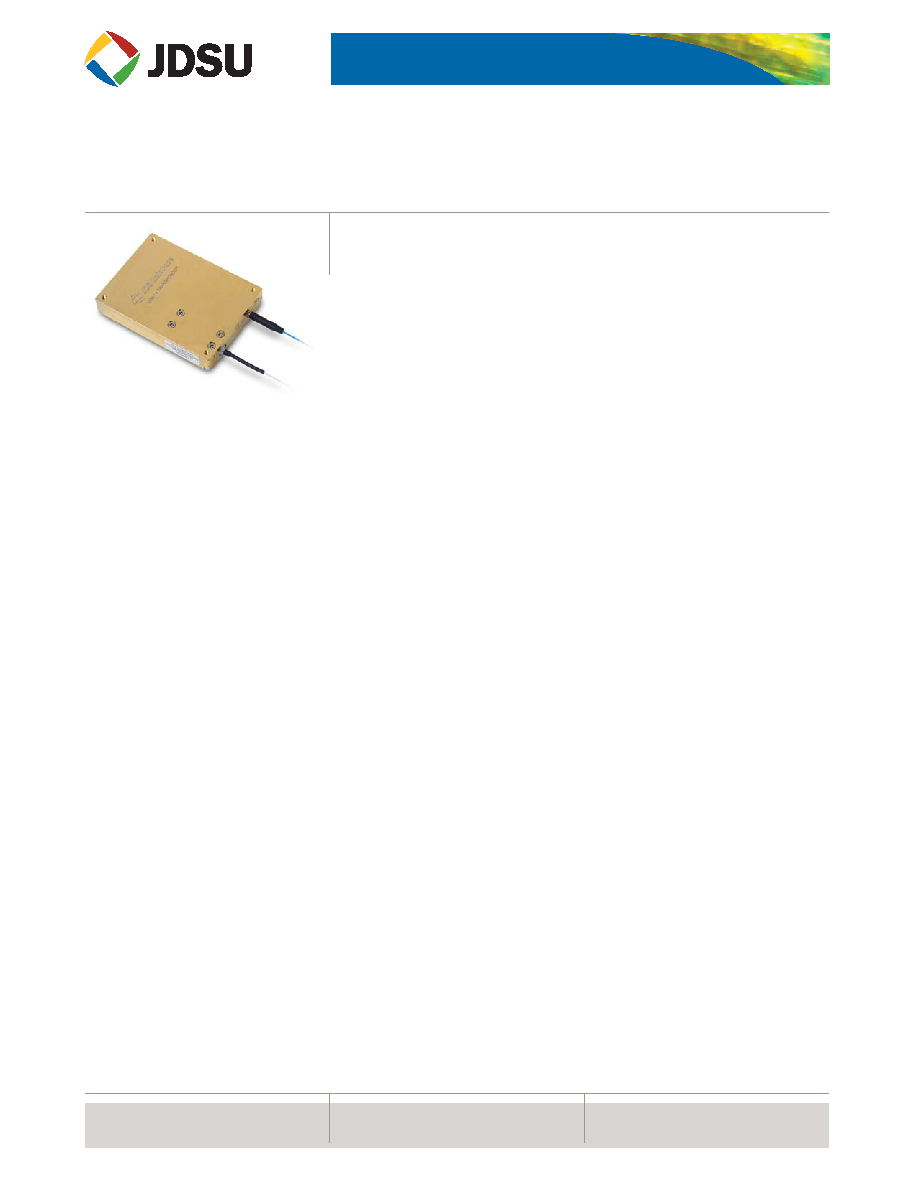- 您現(xiàn)在的位置:買賣IC網(wǎng) > PDF目錄96350 > PH1-TLALC364N (JDS UNIPHASE CORP) FIBER OPTIC TRANSCEIVER, TRANSPONDER, 10660Mbps(Tx), 10660Mbps(Rx), LC/SPC CONNECTOR PDF資料下載
參數(shù)資料
| 型號(hào): | PH1-TLALC364N |
| 廠商: | JDS UNIPHASE CORP |
| 元件分類: | 光收發(fā) |
| 英文描述: | FIBER OPTIC TRANSCEIVER, TRANSPONDER, 10660Mbps(Tx), 10660Mbps(Rx), LC/SPC CONNECTOR |
| 文件頁數(shù): | 1/6頁 |
| 文件大小: | 240K |
| 代理商: | PH1-TLALC364N |

COMMUNICATIONS MODULES & SUBSYSTEMS
Key Features
Three configurations supporting SR2/IR2/LR2 applications
Supports dense wavelength division multiplexing
(DWDM) applications (without wavelocker)
Microprocessor controls to support I2C
Integrated 16:1/1:16 mux/demux
Small form factor package (2.2" x 3.0" x 0.53") for high
density applications
Low power consumption: 4.8 W typical, 6.8 W maximum
for TDM applications
70 °C maximum operating temperature
High sensitivity PIN or APD receivers
SONET, FEC, Ethernet and Multirate Capable Versions
Forward, counter and line timing clocking modes
JDSU 10 Gb/s PH1 Series transponders are intended for 1550 nm system
applications with reaches of up to 80 km. The series includes three different
transponders for SR2 (25 km), IR2 (40 km), and LR2 (80 km) TDM or DWDM
applications. Each transponder accepts 16 bits of parallel digital data and converts
it to a 10 Gb/s NRZ modulated optical signal. It also accepts a 10 Gb/s NRZ
modulated optical signal and converts it into 16 bit wide parallel digital data.
The PH1 series offers low DC power dissipation and is available in either a small
form factor package (2.2 x 3 x 0.53 inches) or in a larger footprint (3.5 x 4.5 x 0.53
inches) package, depending on system thermal performance requirements. The
transmit design uses an Electro-Absorptive Modulated Laser (EML) which,
depending on the configuration, produces an average output power of between
-4 dBm to 2 dBm (EOL). A PIN (-17 dBm typical sensitivity) or APD (-24 dBm
typical sensitivity) receiver is available, based on system configurations.
JDSU PH1 Series transponders are designed to support the following data rates:
9.953 Gb/s (SONET), 10.3125 Gb/s (Ethernet), 10.664 Gb/s (FEC Encoded),
10.709 Gb/s FEC, or 11.09 Gb/s EFEC. They meet all applicable SONET/SDH standards.
Applications
Telecommunications
Metropolitan Area Networks
Subscriber loop
Intra-office SONET/SDH
High bit-rate data communications
Compliance
Telcordia GR-253-Core
10 Gb/sTDM/DWDM 300 Pin SFF MSA SR2/IR2/LR2Transponder
PH1 Series
NORTH AMERICA
: 800 498-JDSU (5378)
WEBSITE
: www.jdsu.com
WORLDWIDE
: +800 5378-JDSU
相關(guān)PDF資料 |
PDF描述 |
|---|---|
| PH1-TLALC3681 | FIBER OPTIC TRANSCEIVER, TRANSPONDER, 10660Mbps(Tx), 10660Mbps(Rx), LC/SPC CONNECTOR |
| PH1-TLALC3721 | FIBER OPTIC TRANSCEIVER, TRANSPONDER, 10660Mbps(Tx), 10660Mbps(Rx), LC/SPC CONNECTOR |
| PH1-TLALC3722 | FIBER OPTIC TRANSCEIVER, TRANSPONDER, 10660Mbps(Tx), 10660Mbps(Rx), LC/SPC CONNECTOR |
| PH1-TLALC3761 | FIBER OPTIC TRANSCEIVER, TRANSPONDER, 10660Mbps(Tx), 10660Mbps(Rx), LC/SPC CONNECTOR |
| PH1-TLALC3805 | FIBER OPTIC TRANSCEIVER, TRANSPONDER, 10660Mbps(Tx), 10660Mbps(Rx), LC/SPC CONNECTOR |
相關(guān)代理商/技術(shù)參數(shù) |
參數(shù)描述 |
|---|---|
| PH1UK12-104 | 制造商:. 功能描述: |
| PH1X1 | 制造商:Eclipse Tools 功能描述: |
| PH1X1-15/16 | 制造商:Eclipse Tools 功能描述: |
| PH-2 10M | 制造商:OMRON AUTOMATION AND SAFETY 功能描述:ELECTRODE UNDERWATER DUAL 10M 制造商:Omron Electronic Components LLC 功能描述:ELECTRODE HOLDER 制造商:OMRON INDUSTRIAL AUTOMATION 功能描述:Electrode Band/Underwater Electrode |
| PH-2 HYPALON 10M | 制造商:OMRON AUTOMATION AND SAFETY 功能描述:ELECTRODE UNDERWATER 10M HYPALON 制造商:Omron Electronic Components LLC 功能描述:10m Cable electrode wHypalon coatin 制造商:OMRON INDUSTRIAL AUTOMATION 功能描述:10M ELECTRODE W/HYPALON COATIN |
發(fā)布緊急采購,3分鐘左右您將得到回復(fù)。